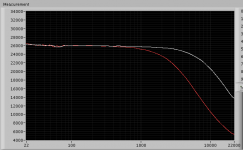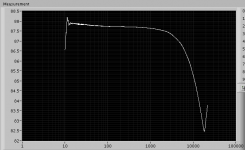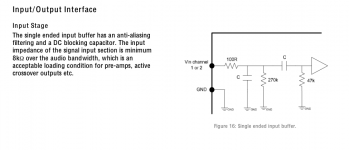I've purchased several of the B&O ICEPower 125ASX2's. The bass is astoundingly granite solid, but the rest of the range wasn't as good as my Hypex amps on my Quad ESL63's. This weekend I decided to put my ears away and strap on my engineering hat and try to understand the differences between my three switching amps (tripath, ICEPower, and Hypex)
I started by inputting a logarithmic sweep into each amp and measuring the output across a 7.5ohm wirewound resistor and measuring the output. I then calculate the difference between the input and output. After I have that "baseline", I then replace the resistor with the Quad ESL63 (which is a nasty reactive load) and repeat the measurement. This was my zero order starting point before I started looking at distortion spectra.
One of the differences in these switching amps is that some change their response with the changes in load (Tripath, I'm looking at you).
Anyway, I saw something horrifying with the ICEPower amp, the treble was rolled off significantly, as you can see in amplifier frequency response graph below.
I've added a potentiometer at the input of the amplifier, and it turns out that the input impedance of these ICEPower amps drops significantly with rising frequency. At DC, the input impedance is 270K, at low frequencies, it drops to about 27K, and at 20KHz it's below 6K. This means that the amp needs a low output impedance source to drive it The beauty of these amps as I saw it was that they were complete with only connectors and an enclosure needed. But it turns out that a simple volume potentiometer put in front of the amp messes up the frequency response significantly.
As seen below in the input schematic, there is an anti-aliasing filter, I unsoldered the grain of salt sized capacitors and the input impedance got much more stable. The input impedance graph on the left shows the input impedance with and without this filter.
I'm building an Op-Amp buffer stage to go between the potentiometer and the amplifier input. The op-amp stage will be powered from the auxilary output of the amp itself.
Keep this "feature" in mind when you consider this design.
Sheldon
I started by inputting a logarithmic sweep into each amp and measuring the output across a 7.5ohm wirewound resistor and measuring the output. I then calculate the difference between the input and output. After I have that "baseline", I then replace the resistor with the Quad ESL63 (which is a nasty reactive load) and repeat the measurement. This was my zero order starting point before I started looking at distortion spectra.
One of the differences in these switching amps is that some change their response with the changes in load (Tripath, I'm looking at you).
Anyway, I saw something horrifying with the ICEPower amp, the treble was rolled off significantly, as you can see in amplifier frequency response graph below.
I've added a potentiometer at the input of the amplifier, and it turns out that the input impedance of these ICEPower amps drops significantly with rising frequency. At DC, the input impedance is 270K, at low frequencies, it drops to about 27K, and at 20KHz it's below 6K. This means that the amp needs a low output impedance source to drive it The beauty of these amps as I saw it was that they were complete with only connectors and an enclosure needed. But it turns out that a simple volume potentiometer put in front of the amp messes up the frequency response significantly.
As seen below in the input schematic, there is an anti-aliasing filter, I unsoldered the grain of salt sized capacitors and the input impedance got much more stable. The input impedance graph on the left shows the input impedance with and without this filter.
I'm building an Op-Amp buffer stage to go between the potentiometer and the amplifier input. The op-amp stage will be powered from the auxilary output of the amp itself.
Keep this "feature" in mind when you consider this design.
Sheldon
Attachments
Its not unusual to have low input impedance inputs in class d amps.
The datasheet circuit for an IRS2092 shows a 3k3 resistor on the input.
The datasheet circuit for an IRS2092 shows a 3k3 resistor on the input.
Its not unusual to have low input impedance inputs in class d amps.
The datasheet circuit for an IRS2092 shows a 3k3 resistor on the input.
Low input impedance would be fine, but low and changing by 4x over the frequency range is not OK in my book.
I loved my little 125ASX until I dropped it one too many time. Poor little fellow. 🙁
Agreed, rock solid bass. Having the PSU right there onboard has to help.
Don't count too much on the aux power supply. It's very flaky. Too bad, it would be handy for exactly what you have in mind.
On mine I reworked that input a little and removed both caps and the 270K resistor. As there did not seem to be any DC at the input, it was not a big deal. Seemed to sound a lot better.
Thanks for posting this, these modules are underrated, IMO.
Agreed, rock solid bass. Having the PSU right there onboard has to help.
Don't count too much on the aux power supply. It's very flaky. Too bad, it would be handy for exactly what you have in mind.
On mine I reworked that input a little and removed both caps and the 270K resistor. As there did not seem to be any DC at the input, it was not a big deal. Seemed to sound a lot better.
Thanks for posting this, these modules are underrated, IMO.
I have noticed this too. I have a pair of Icepower 1000ASP's on the bass panels of my Magnepan Tympani IVa, with either a pair of Icepower 500A or a Class A amp on the HF panels (summer and winter setups - the Aleph 5 has double duty as a space heater) .
Even with the 500A on HF, I still have to boost the gain on the HF panels even though the gain of the 1000ASP and the 500A are very close. This was confirmed with test tones and a SPL meter.
The Behringer DCX2496 I use to Biamp has a nice low input impedance for the Icepowers (both 1000ASP and 500A), so you may want to try this if you are biamping...
Even with the 500A on HF, I still have to boost the gain on the HF panels even though the gain of the 1000ASP and the 500A are very close. This was confirmed with test tones and a SPL meter.
The Behringer DCX2496 I use to Biamp has a nice low input impedance for the Icepowers (both 1000ASP and 500A), so you may want to try this if you are biamping...
Can someone give me some hints building an amp-plate with these modules and what i have to consider?
First my plan was to use a hypex ds4.0 plate amp for each sub but my plan changed and now i have these 125asx2 modules and going to feed them with a balanced signal coming from a miniDSP.
As this is my first project building complete HT subs with amps i need to know if an enclosure is needed for the 125asx2 or can i fix it without any problems on a simple aluminium plate?
Should i use a ferrit behind the AC powercord? Should i connect the yellow/green earth wire somewhere on the amp/plate? As i know all wires should be twisted?
First my plan was to use a hypex ds4.0 plate amp for each sub but my plan changed and now i have these 125asx2 modules and going to feed them with a balanced signal coming from a miniDSP.
As this is my first project building complete HT subs with amps i need to know if an enclosure is needed for the 125asx2 or can i fix it without any problems on a simple aluminium plate?
Should i use a ferrit behind the AC powercord? Should i connect the yellow/green earth wire somewhere on the amp/plate? As i know all wires should be twisted?
hi, Sheldon!
thanks for the meassurments of the ice power input impedance. I built a tube buffer with phasesplitter for the 125 BTL which is able to drive 4k load. this works fine but the sound of the ice power module is a little bit "squeaky". The mid-range seems to be dominant combined with a loss at high frequency. My assumption now is that the ice power changes frequency response with the changing impedance of the speaker. I connot meassure the frequency response of the amp because I don´t have a ground-free meassurment equipment. I can meassure the response at the input of the amp, after the input buffer and it looks ok.: (-0.5dB @20kHz.).If you have made similar experiences, please let me know.
robert
thanks for the meassurments of the ice power input impedance. I built a tube buffer with phasesplitter for the 125 BTL which is able to drive 4k load. this works fine but the sound of the ice power module is a little bit "squeaky". The mid-range seems to be dominant combined with a loss at high frequency. My assumption now is that the ice power changes frequency response with the changing impedance of the speaker. I connot meassure the frequency response of the amp because I don´t have a ground-free meassurment equipment. I can meassure the response at the input of the amp, after the input buffer and it looks ok.: (-0.5dB @20kHz.).If you have made similar experiences, please let me know.
robert
These measurements are very interesting to me, but I'm afraid I don't know quite enough about impedance and potentiometers.
I've read that the output impedance of a potentiometer changes between 0 and its nominal value, according to its position. Then wouldn't a pot with a nominal resistance of 100K almost always have an adverse effect on the receiving end, when it's not turned more than halfway up?
I mean, if the input impedance on the receiving end should be ten times larger (right?) than the output impedance on the sending end, it would have to be between 250K and 1000K!
I realize that the specs for the ICEpower are particularly bad, but wouldn't it seem from my naïve calculations that a buffer stage is always needed in front of a potentiometer?
I've read that the output impedance of a potentiometer changes between 0 and its nominal value, according to its position. Then wouldn't a pot with a nominal resistance of 100K almost always have an adverse effect on the receiving end, when it's not turned more than halfway up?
I mean, if the input impedance on the receiving end should be ten times larger (right?) than the output impedance on the sending end, it would have to be between 250K and 1000K!
I realize that the specs for the ICEpower are particularly bad, but wouldn't it seem from my naïve calculations that a buffer stage is always needed in front of a potentiometer?
Last edited:
buffer for ice power
hi, dalgard!
You can not use a potentiometer as a input buffer. The potentiometer makes the situation worse than without.
Which device do you use to drive the icepower?
Most of the common used pre-amps today can drive amps like the ice power family.
Which model of ice power amp. do you have?
hi, dalgard!
You can not use a potentiometer as a input buffer. The potentiometer makes the situation worse than without.
Which device do you use to drive the icepower?
Most of the common used pre-amps today can drive amps like the ice power family.
Which model of ice power amp. do you have?
Anyway, I saw something horrifying with the ICEPower amp, the treble was rolled off significantly, as you can see in amplifier frequency response graph below.
Sheldon
Sheldon check this out see a comment
"Another major difference from ICEpower to UcD is that ICEpower modulator does not damp output filter properly and relies on a 5 ohm resistor mounted on the heatsink for some damping (which imposes limitations on sustained trebble output)"
http://www.diyaudio.com/forums/class-d/159012-reinventing-icepower-topology.html
I 'd try to mod the input filter of 125asx2 by removing and short coupling C. Could someone please point the position of these C . The smd layout is very small.
Hi,
sorry do dig up this really old thread. I have an amp using the 125ASX2. I have a 10k potmeter in front of it and have been thinking about adding an input buffer for a long time. Did you ever complete the input op-amp buffer? Do you know the capacitance of the two capacitors in the anti-aliasing filter? I did a quick simulation to try to match your measurements and my guess is that the first capacitor(to GND) may be something like 1.2nF and the second one (series connected) is "large". Maybe 10uF?
BR,
Øyvin Eikeland
sorry do dig up this really old thread. I have an amp using the 125ASX2. I have a 10k potmeter in front of it and have been thinking about adding an input buffer for a long time. Did you ever complete the input op-amp buffer? Do you know the capacitance of the two capacitors in the anti-aliasing filter? I did a quick simulation to try to match your measurements and my guess is that the first capacitor(to GND) may be something like 1.2nF and the second one (series connected) is "large". Maybe 10uF?
BR,
Øyvin Eikeland
Hi, reading the forum, I recently finished an amplifier with ICEPower 125ASX2 module, which is giving me great satisfaction.
As a simple self-builder, without technical training, I share this project with you, hoping it will be useful to someone novice but who wants a complete and well-sounding amplifier. Everyone can improve it.
I don't speak English well, so I apologize for my language. I'll ask my friend Google Translate for help.
Have a nice Sunday.
As a simple self-builder, without technical training, I share this project with you, hoping it will be useful to someone novice but who wants a complete and well-sounding amplifier. Everyone can improve it.
I don't speak English well, so I apologize for my language. I'll ask my friend Google Translate for help.
Have a nice Sunday.
After some experimentation, I got the best sound quality from the single Muses01 buffer/preamp (seems to have the smoothness of a tube with the extension of a solid state) and the Japanese TKD potentiometer (seems to sound like a resistor ladder). Both are expensive, but they are very noticeable in the audio signal path.
Compared to my Aiyima 04, implemented with some audio grade components, in my opinion, the 125ASX2 with Muses01 preamp sounds two decimal points better.
Last edited:
I've uploaded a few tests on asr of the new conductor version compared to a 400a2.
The edge 400a2 still tests better but none of this is audible. I've done a listening test with the 1200as2, 400a2, conductor 125asx2 and a purifi 1et400a and cannot tell a difference.
The 125asx2 has some power supply noise compared to the 1200as2 but the noise floor is lower so it looks worse.
https://www.audiosciencereview.com/forum/index.php?threads/icepower-conductor.45823/page-2
The edge 400a2 still tests better but none of this is audible. I've done a listening test with the 1200as2, 400a2, conductor 125asx2 and a purifi 1et400a and cannot tell a difference.
The 125asx2 has some power supply noise compared to the 1200as2 but the noise floor is lower so it looks worse.
https://www.audiosciencereview.com/forum/index.php?threads/icepower-conductor.45823/page-2
Has anyone compared them with the Fosi v3 monoblock amps? I compared the old 125asx2btl and 50asx2btl to the Fosi v3 mono, and it is much clearer sounding, with a tighter bass and zero hiss with my K402MEH setup. Granted my Icepower amps are 7 years old, and the Fosi v3 is much newer tech.
The biggest issue people complained on 1200as2 is the big phase shift, almost 70º at 20 kHz, the new Conductor suppose to improve a lot.
The phase shift is a non issue in the real world.
If it was 90deg at 2k it may be an issue mixing amps in an active system. I can't see an issue in a full passive system. I use the 1200as2 to run the woofers(sb34nrxl75-8) upto 250hz in my 3 way active system. I works great and the 400a2 powered from it is also awesome running the midrange.
If it was 90deg at 2k it may be an issue mixing amps in an active system. I can't see an issue in a full passive system. I use the 1200as2 to run the woofers(sb34nrxl75-8) upto 250hz in my 3 way active system. I works great and the 400a2 powered from it is also awesome running the midrange.
- Home
- Amplifiers
- Class D
- ICEpower 125ASX2 Measurements and Mods


